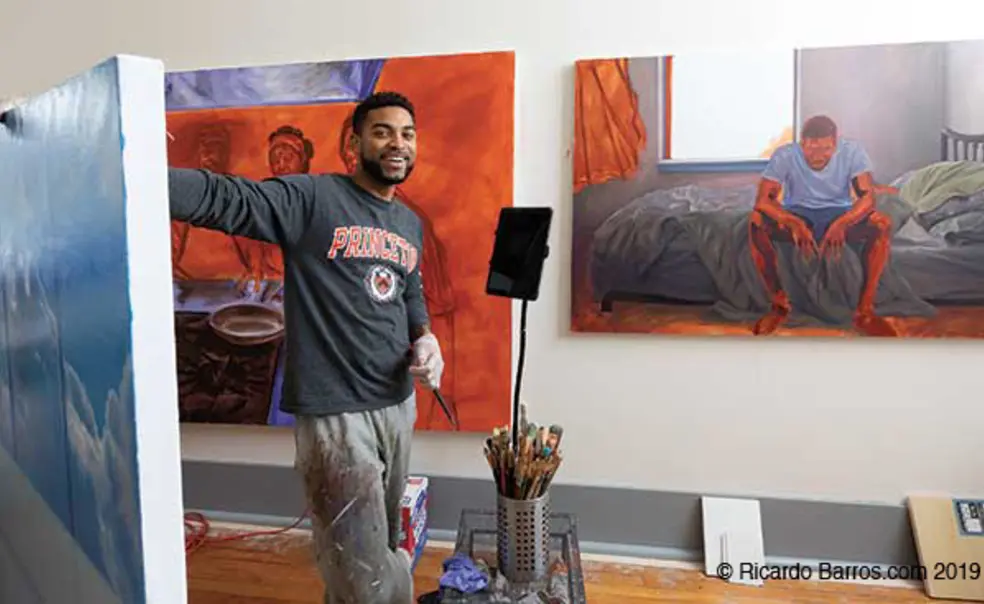Special Promise: Early-Career Artists, Humanists Enjoy a Year To Create as Hodder Fellows
Artists at Princeton are nothing new, but each year one group stands out: the five Hodder Fellows, sponsored by the Lewis Center for the Arts.
If you’ve noticed a lanky, bearded man sketching African American workers on campus, you’ve probably seen Mario Moore, one of the current Hodder Fellows. Said Moore, a painter who also sculpts, “I’m working on a series of paintings, black men working blue-collar jobs, like in the dining hall, but I hope to expand to off campus.” Moore approaches his subjects and chats with them, then sketches his ideas before starting to paint. “The Hodder has given me space and time,” he said. “I have a studio where I can make sculpture and larger work than I could in my New York City apartment.”
The fellowship was first awarded to the poet, critic, and Princeton faculty member R.P. Blackmur in 1944. The award came from a bequest by Mary Mackall (Mamie) Gwinn, an English professor at Bryn Mawr who married Alfred Hodder, another Bryn Mawr professor. Mary Hodder lived her last years in Princeton.
Over the years, the ranks of the Hodder fellows have included the poet John Berryman (1950), the historian Peter Gay (1955), and novelist and 2008 MacArthur Fellow Chimamanda Ngozi Adichie (2005) — whose 2013 novel Americanah opens with a scene in Princeton. Over the past couple of decades, the number of annual fellows increased from one to five, and the eligible fields have expanded to visual and performing arts.
The current year’s Hodder Fellows include the playwrights Martyna Majok and Lauren Yee, the choreographer Okwui Okpokwasili, and the poet Jacob Shores-Argüello. Shortly after winning a Hodder, Majok, who had earned attention as the author of gritty plays like Ironbound and Queens, won the Pulitzer Prize in drama for her play Cost of Living. “For the Hodder, I’m writing the book and lyrics for an original musical about Chernobyl,” she explained. “It’s about the search for home: about re-making your life, re-settling, and returning. It’s a project that’s been close to my heart for almost a decade.” Okpokwasili, who described her recent work as based on protest practices of women in southeast Nigeria in the early 20th century, received a 2018 MacArthur fellowship. “My collaborator and I are building a platform for the creation of an improvisational public song,” she said.
Judges for the fellowship are the heads of the programs at the Lewis Center — dance, musical theater, and creative writing — as well as the chair of the music department.
Michael Cadden, the chair of the Lewis Center, said the judges “look at work that’s already been done and recognized, evidence that you’re on the way to an important career.” The rewards are substantial, from financial independence for a year to the career boost that winning a Hodder gives. The stipend these days hovers around $82,000, about the pay of an assistant professor at Princeton, but with no teaching duties or even a residency requirement.
The judges also try to determine how valuable Princeton’s resources would be for the applicants, who can take advantage of anything from studio and performance space to a chance to meet other arts professionals.
“One of the great secret benefits of the Hodder is the time you get to spend with Princeton’s creative-writing faculty,” said Whitney Terrell ’91, a writer and Hodder Fellow in 2008–09. Terrell, a graduate of the creative-writing program, enjoyed the chance to see his former professors, such as Joyce Carol Oates, James Richardson ’71, and John McPhee ’53, while developing relationships with other faculty that have continued after his fellowship year.
In December the selection of next year’s fellows was announced: visual artist Ryan Gander, choreographer Will Rawls, novelist Kaitlyn Greenidge, poet Nicole Sealey, and playwright Hansol Jung.
Gander, whose art merges painting and sculpture and writing, calls the subject of his work “Loose Associations” — in books and performative lectures, as well as documents and objects. Confined to a wheelchair, he has also made art of his condition, presenting audiences with images of disability.
Rawls says he confronts “historical notions of blackness and the rules of standard English to craft choreography that challenges a performer’s apparent social roles”: In Uncle Rebus, commissioned for New York City’s High Line Art, dancers arranged letters to spell out selections from Br’er Rabbit Tales.
Greenidge’s debut novel, We Love You, Charlie Freeman, was one of The New York Times Critics’ Top Books of 2016, and Sealey’s poetry collection Ordinary Beast was a finalist for the 2018 PEN Open Book Award and the 2018 Hurston/Wright Legacy Award. Jung, whose plays include Cardboard Piano and Among the Dead, has also translated more than 30 musicals into Korean.
Not surprisingly, the competition for the fellowships is stiff. “We had 1,100 applications this year,” Cadden said. “It’s a good gig.”












No responses yet